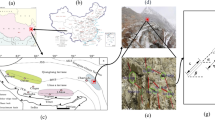Abstract
This paper shows the ability of the cohesive crack model to predict reasonably well the behaviour of concrete specimens. To demonstrate this two very different examples are considered. The first is an engineering problem related to the breakage of precase concrete piles; it is shown that the cohesive crack model points to the relevant parameters and suggests ways to improve the behaviour of the concrete. The second example analyses the well known effect of size on the modulus of rupture when measured during the three point bending of beams. The predictions using a simple cohesive model with bilinear softening are very good. The present work shows how this model not only predicts accurately the maximum loads for different geometries and sizes but also is able to make reasonably good predictions of load and displacement at any instant throughout the test.
Resume
On montre ici l'aptitude du modèle de fissure cohésive à prédire de façon significative le comportement d'éprouvettes de béton. Dans ce but, on considère deux exemples assez différents.
Dans le premier cas, il s'agit d'un problème de génie civil relatif à la rupture de pieux en béton préfabriqué. Ces pieux, fabriqués avec deux bétons présentant les mêmes propriétés mécaniques standard (résistance à la traction et à la compression, module d'élasticité), se sont comportés de façon différente, l'une des séries étant plus fragile que l'autre. Les concepts du modèle de fissuration cohésive ont donné des clés pour comprendre ce problème en identifiant le paramètre dominant, la longueur caractéristique, et en suggérant des méthodes pour améliorer sa valeur.
Le second cas concerne l'effet d'échelle, bien connu, sur la résistance à la flexion mesurée sur des éprouvettes en flexion à trois points. Les résultats expérimentaux montrent une bonne concordance avec les prédictions basées sur un modèle de fissure cohésive simple avec amollissement bi-linéaire. Les quatre paramètres de la courbe ont été déterminés par la méthode GBF (General Bilinear Fitting) proposée par l'auteur et son équipe.
Similar content being viewed by others
References
Neville, A. M., ‘Properties of Concrete’ (Pitman, London, 1981).
Comité Euro-International du Béton, ‘CEB-FIP Model Code 1990’, Bulletín d'Information du CEB no 21, July 1991.
Planas, J. and Elices, M., ‘Towards a measure ofG F: An analysis of experimental results’, in ‘Fracture Toughness and Fracture Energy of Concrete’, edited by F. H. Wittmann (Elsevier, Amsterdam, 1985) pp. 381–390.
Neville, A. M., ‘Some aspects of the strength of concrete’,Civil Engng,54 (1959), Part 1, 1153–1156; Part 2, 1308–1311; Part 3, 1435–1439.
Kaplan, F. M., ‘Crack propagation and the fracture of concrete’,J. Amer. Concr. Inst. 58 (1961) 591–610.
Chappell, J. F. and Ingraffea, A. R., ‘A fracture mechanics investigation of the cracking of Fontana dam’, Structural Engineering Report 81-7, (School of Civil and Environmental Engineering, Cornell University, Ithaca, NY, 1981).
Martha, L. F., LLorca, J., Ingraffea, A. R. and Elices, M., ‘Numerical simulation of crack initiation and propagation in an arch dam’,Dam Engng, II,3 (1990) 193–213.
Gálvez, K., LLorca, J. and Elices, M., ‘Stability of concrete gravity dams: A fracture mechanics approach’, in “Dam Fracture and Damage”, edited by Bourdarotet al. (Balkema, Rotterdam, 1994) pp. 31–40.
Hillberborg, A., Modéer, M., and Petersson, P. E., ‘Analysis of crack formation and crack growth in concrete by means of fracture mechanics and finite elements’,Cement Concr. Res. 6 (1976) 773–782.
Planas, J. and Elices, M., ‘Nonlinear fracture of cohesive materials’,Int. J. Fracture 51 (1991) 139–157.
Barenblatt, G. J., ‘The mathematical theory of equilibrium crack in brittle fracture’,Adv. Appl. Mech.,7 (1962) 55–125.
Guinea, G. V., Planas, J. and Elices, M., ‘A general bilinear fit for the softening curve of concrete’,Mater. Struct. 27 (1994) 99–105.
Petersson, P. E., ‘Crack growth and development of fracture zone in plain concrete and similar materials’, Report TVBM-1006 (Division of Building Materials, Lund Inst. of Technology, 1981).
Reinhardt, H. W., Cornelissen, H. A. W. and Hordijk, D. A., ‘Tensile tests and failure analysis of concrete’,J. Struct. Engng ASCE 112 (1986) 2462–2477.
van Mier, J. G. M., ‘Fracture of concrete under complex stress’,Heron 31 (1986) 2–90.
Mihashi, H., ‘Material structure and tension softening properties of concrete’, in ‘Fracture Mechanics of Concrete Structures’, edited by Z. P. Bazant (Elsevier, Amsterdam, 1992) pp. 239–250.
Guinea, G. V., Planas, J. and Elices, M., ‘Correlation between the softening and the size effect curves’, in ‘Size Effect in Concrete Structures’, edited by H. Mihashiet al. (E&FN Spon, London, 1994) pp. 233–244.
RILEM, ‘Draft Recommendation: Determination of fracture energy of mortar and concrete by means of three point bend test on notched beams’,Mater. Struct. 18 (1985) 285–290.
Guinea, G. V., Planas, J. and Elices, M., ‘Measurement of the fracture energy using three point bend tests: Part 1 —Influence of experimental procedures’,Mater. Struct. 25 (1992) 212–218.
Idem,, ‘Measurement of the fracture energy using three point bend tests: Part 2—Influence of bulk energy dissipation’,-Ibid. 25 (1992) 305–312.
Idem,, ‘Measurement of the fracture energy using three point bend tests: Part 3—Influence of cutting theP-δ tail’,-Ibid,25 (1992) 327–334.
Planas, J., Elices, M. and Guinea, G. V., ‘Softening curves for concrete and structural response’, in ‘Fracture and Damage of Concrete and Rock’, edited by H. P. Rossmanith (E&FN Spon, London, 1993) pp. 357–368.
Hillerborg, A., ‘Existing methods to determine and evaluate fracture toughness of aggregative materials—RILEM recommendation on concrete’, in Fracture Toughness and Fracture Energy’, edited by H. Mihashiet al. (Balkema, Rotterdam, 1989) pp. 145–151.
Planas, J. and Elices, M., ‘Asymptotic analysis of a cohesive crack: 1. Theoretical background’,Int. J Fracture 55 (1992), 153–177.
Elfgren, L., ‘Applications of fracture mechanics to concrete structures’, in ‘Fracture Toughness and Fracture Energy’, edited by H. Mihashiet al. (Balkema, Rotterdam 1989) pp. 575–590.
Author information
Authors and Affiliations
Additional information
This paper is the final version of the lecture delivered by the author when he was awarded the Robert L'Hermite Medal during the 48th meeting of RILEM General Council in Trento on 30 September 1994.
Rights and permissions
About this article
Cite this article
Guinea, G.V. Modelling the fracture of concrete: the cohesive crack. Materials and Structures 28, 187–194 (1995). https://doi.org/10.1007/BF02473248
Issue Date:
DOI: https://doi.org/10.1007/BF02473248




